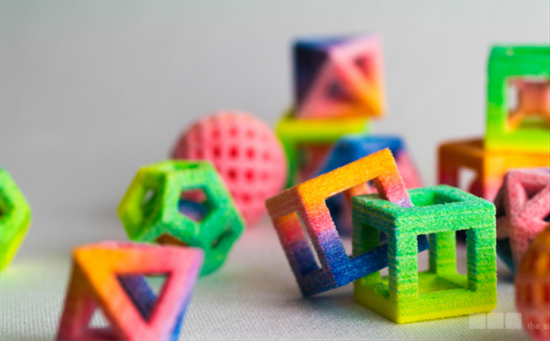 The world of 3D printing has already expanded into most industries, from healthcare to housewares. 3D printed food has also been making waves recently, with companies like 3D Systems’ Sugar Lab crafting edible sculptures out of brightly colored sugar. Right now, these breakthrough devices are mainly targeted for restaurants at the forefront of cuisine, but in time they will be affordable for home use as well. They work in a similar way to normal 3D printers, only they extrude layers of dry sugar from a nozzle and then crystallize them with concentrated water jets. Using this tool, geometric and abstract shapes can easily be created in tasty sugar form.
The world of 3D printing has already expanded into most industries, from healthcare to housewares. 3D printed food has also been making waves recently, with companies like 3D Systems’ Sugar Lab crafting edible sculptures out of brightly colored sugar. Right now, these breakthrough devices are mainly targeted for restaurants at the forefront of cuisine, but in time they will be affordable for home use as well. They work in a similar way to normal 3D printers, only they extrude layers of dry sugar from a nozzle and then crystallize them with concentrated water jets. Using this tool, geometric and abstract shapes can easily be created in tasty sugar form.
In addition to sugar, some food printers have utilized chocolate and pizza dough (respectively) as raw materials for the extrusion process. We’re not quite at a Jetsons level where entire meals can be constructed in seconds, but that futuristic vision isn’t too far off. Until then, here are a few practical applications for 3D printed food are being developed right now:
- Food for Seniors: Older people with dentures or sensitive teeth often end up reverting back to a diet of soft foods, which usually come in an unappetizing, mushy form. Today’s 3D printed food technology can take vegetables like carrots or broccoli, mash them up, and then reshape them into soft replicas of the original food. The finished product still looks delicious and is a lot easier to swallow.
- Drink Decorations: Some cocktail bars have employed the latest sugar-based printers to create gorgeous garnishes for their specialty drinks. Some of these decorative pieces are so strange and beautiful that they elevate the cocktail to a visual art form. Mixologists can even pour the drink onto the sugar sculpture, infusing the cocktail with sweetness as the sugar slowly melts.
- Cake Accents: Wedding cakes are known for their elaborate and eye-catching designs, but what if you could print edible versions of the happy couple in 3D? Perhaps the two of you have a memorable inside joke that you want to recreate in sugar — for example, that whitewater rafting trip you took with the family last year, where the groom fell out of the raft and the bride had to save him. With a sugar-based 3D printer, you could re-enact that raft scene on top of your cake and laugh about it together as a family.
- Personalized Food: Finally, this area of food printing is still in very early stages, but scientists have started to envision how 3D printers could create custom meals that provide us with catered nutrition for our bodies. Health sensors on your phone can already document your burned calories and overall diet, but combined with a food printer, the program could suggest entrees with the right amount of vitamins, proteins, or fats.
My husband REALLY wants a 3D printer but they are so expensive that I am not onbaord yet. I might be if I could make cake decorations!
I totally can’t wait till I can afford-ably PRINT dinner 😉